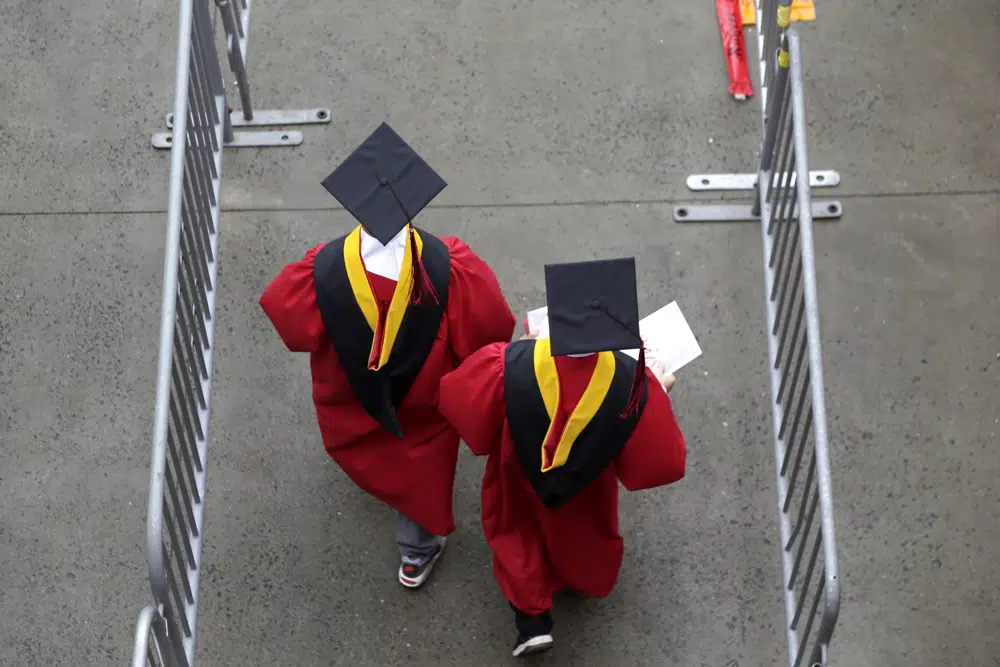FILE – New graduates walk into the High Point Solutions Stadium before the start of the Rutgers University graduation ceremony in Piscataway Township, N.J., on May 13, 2018. The Supreme Court is about to hear arguments over President Joe Biden’s student debt relief plan. It’s a plan that impacts millions of borrowers who could see their loans wiped away or reduced. (AP Photo/Seth Wenig, File)
WASHINGTON (AP) — The Supreme Court is about to hear arguments over President Joe Biden’s student debt relief plan, which impacts millions of borrowers who could see their loans wiped away or reduced.
So far, Republican-appointed judges have kept the Democratic president’s plan from going into effect, and it remains to be seen how the court, dominated 6-3 by conservatives, will respond. The justices have scheduled two hours of arguments in the case Tuesday, though it will probably go longer. The public can listen in on the court’s website beginning at 10 a.m. EST.
Where things stand ahead of the hearing as well as what to expect:
HOW DOES THE FORGIVENESS PLAN WORK?
The debt forgiveness plan announced in August would cancel $10,000 in federal student loan debt for those making less than $125,000 or households with less than $250,000 in income per year. Pell Grant recipients, who typically demonstrate more financial need, would get an additional $10,000 in debt forgiven.
WASHINGTON (AP) — The Supreme Court is about to hear arguments over President Joe Biden’s student debt relief plan, which impacts millions of borrowers who could see their loans wiped away or reduced.
So far, Republican-appointed judges have kept the Democratic president’s plan from going into effect, and it remains to be seen how the court, dominated 6-3 by conservatives, will respond. The justices have scheduled two hours of arguments in the case Tuesday, though it will probably go longer. The public can listen in on the court’s website beginning at 10 a.m. EST.
Where things stand ahead of the hearing as well as what to expect:
HOW DOES THE FORGIVENESS PLAN WORK?
The debt forgiveness plan announced in August would cancel $10,000 in federal student loan debt for those making less than $125,000 or households with less than $250,000 in income per year. Pell Grant recipients, who typically demonstrate more financial need, would get an additional $10,000 in debt forgiven.
College students qualify if their loans were disbursed before July 1. The plan makes 43 million borrowers eligible for some debt forgiveness, with 20 million who could have their debt erased entirely, according to the Biden administration.
The White House says 26 million people have applied for debt relief, and 16 million people had already had their relief approved. The Congressional Budget Office has said the program will cost about $400 billion over the next three decades.
HOW DID THE ISSUE WIND UP AT THE SUPREME COURT?
The Supreme Court is hearing two challenges to the plan. One involves six Republican-led states that sued. The other involves a lawsuit filed by two students.
A lower court dismissed the lawsuit involving the following states: Arkansas, Iowa, Kansas, Missouri, Nebraska and South Carolina. The court said the states could not challenge the program because they weren’t harmed by it. But a panel of three federal appeals court judges on the U.S. Court of Appeals for the 8th Circuit — all of them appointed by Republican presidents — put the program on hold during an appeal. The Supreme Court then agreed to weigh in.
The students’ case involves Myra Brown, who is ineligible for debt relief because her loans are commercially held, and Alexander Taylor, who is eligible for just $10,000 and not the full $20,000 because he didn’t receive a Pell grant. They say that the Biden administration didn’t go through the proper process in enacting the plan, among other things.
Texas-based U.S. District Judge Mark Pittman, an appointee of President Donald Trump, sided with the students and ruled to block the program. Pittman ruled that the Biden administration did not have clear authorization from Congress to implement the program. A federal appeals court left Pittman’s ruling in place, and the Supreme Court agreed to take up the case along with the states’ challenge.
HOW DID BIDEN GET TO CANCEL THE DEBT?
To cancel student loan debt, the Biden administration relied on the Higher Education Relief Opportunities for Students Act, commonly known as the HEROES Act. Originally enacted after the Sept. 11, 2001, terror attack, the law was initially intended to keep service members from being worse off financially while they fought in wars in Afghanistan and Iraq. Now extended, it allows the secretary of education to waive or modify the terms of federal student loans as necessary in connection with a national emergency.
Trump, a Republican, declared the COVID-19 pandemic a national emergency in March 2020, but Biden recently announced that designation will end May 11. The Biden administration has said that the end to the national emergency doesn’t change the legal argument for student loan debt cancellation because the pandemic affected millions of student borrowers who might have fallen behind on their loans during the emergency.
WHAT ARE THE JUSTICES LIKELY TO ASK ABOUT?
Expect the justices to be focused on several big issues. The first one is whether the states and the two borrowers have the right to sue over the plan in the first place, a legal concept called “standing.” If they don’t, that clears the way for the Biden administration to go ahead with it. To prove they have standing, the states and borrowers will have to show in part that they’re financially harmed by the plan.
Beyond standing, the justices will also be asking whether the HEROES Act gives the Biden administration the power to enact the plan and how it went about doing so.
WHEN WILL BORROWERS KNOW THE OUTCOME?
It will likely be months before borrowers learn the outcome of the case, but there’s a deadline of sorts. The court generally issues all of its decisions by the end of June before going on a summer break.
Whether or not the debt gets cancelled, the case’s resolution will bring changes. While federal student loan payments are currently paused, that will end 60 days after the case is resolved. And if the case hasn’t been resolved by June 30, payments will start 60 days after that.
Copyright 2021 Associated Press. All rights reserved.






























You must be logged in to post a comment Login